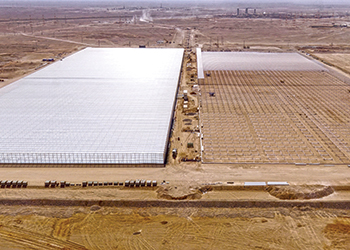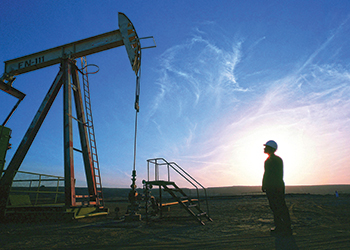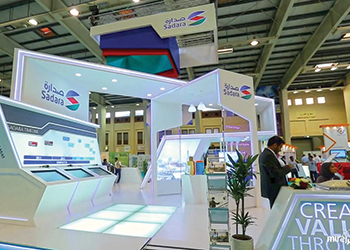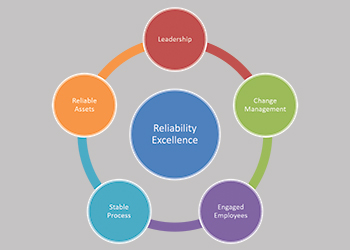
 PDO ... keeping activity levels at full tilt
PDO ... keeping activity levels at full tilt
Gas production in Oman is needed to meet the power demands of the country’s growing industrial base, with sector consumption expected to rise from 6.7 billion cubic metres in 2015 to 10 billion cubic metres by 2020
Petroleum Development Oman (PDO), the leading oil and gas exploration and production company in Oman, projects investments of around $20 billion being ploughed into its oil and gas operations over the next five years, although capital expenditure is anticipated to be curtailed further in 2017 and beyond.
Raoul Restucci, PDO managing director, says the majority state-owned company will continue to run a lean and efficiency operation in 2017, while however keeping activity levels at full tilt.
"As far as the outlook for 2017 is concerned, you are going to see a company performing as well as in 2016 and before," Restucci says. "We will be focusing on minimising capital requirements, improving efficiency, finding self-reliant ways of funding ourselves, continuing with our Lean programmes, continuing with our ICV programmes, and so on. So we stay the course on all the key foundations. We are very much excited, and we have a number of opportunities, which we are continuing to progress and deliver."
Cuts in capital expenditure are expected to mirror those in 2016, the managing director says. "We are doing are best obviously to reduce (capex), not only for 2017 but also 2018. But there will be very high levels of activity, and very high levels of drilling. We drilled more than 600 wells in 2016 and we are going doing the same in 2017. So activity-wise, we are continuing very strongly!" Commenting on PDO’s share of the 45,000 barrels per day (bpd) output cut that Oman has pledged as part of a global deal to bolster oil prices, Restucci states: "We will take an equitable percentage; we will review the timing and deliver what the Ministry of Oil & Gas seeks in this regard."
Significantly, a production cut will pose "no issues" for the company’s operations, he notes. "We have a portfolio which is robust and strong. We are looking at increasing incremental activities but in the short term, if we are requested to cut down a little bit, it’s not going to be an issue. We will only have to optimise the scheduling of our (maintenance shutdown) activities."
Oman is seeking to enhance its upstream gas segment to supply growing demand, with major upcoming projects expected to help achieve this goal, as the sultanate is ‘changing the focus’ and becoming ‘more of a gas-driven nation’.
Oman produced more than 100 million standard cubic metres per day (mmscmd) of gas last year, a 3.5 per cent increase on the 2015 figure, says Salim bin Nasser al Aufi, Under-Secretary of the Ministry of Oil and Gas (MOG).
Higher levels of output have fed into GDP, with data from the National Centre for Statistics and Information showing that the natural gas sector increased its contribution to nominal GDP by 2.7 per cent last year to RO1.19 billion ($3.1 billion).
By comparison, crude oil’s input shrank by 27.5 per cent to RO5.79 billion ($15 billion).
Gas production in the sultanate is needed to meet the power demands of the country’s growing industrial base, with sector consumption expected to rise from 6.7 billion cubic metres in 2015 to 10 billion cubic metres by 2020, according to the Oman Power and Water Procurement Company.
 |
Restucci ... doing the best to reduce capex |
With overall demand forecast to grow at an annual rate of 7.3 per cent between 2016 and 2025, according to Business Monitor International, the challenge for Oman will be to continue to develop new reserves.
One such source is the $16 billion Khazzan gas field project, which is being developed by BP in partnership with Oman Oil Company (OOC). Following an amendment to the original exploration and production sharing agreement last November, the area licensed for development now covers some 3,700 sq km, making it one of the region’s largest unconventional tight gas accumulations. By November BP had completed more than 80 per cent of the project’s first phase and is expected to deliver gas before the end of this year. With the addition of the second phase, scheduled for completion in 2020, BP expects the project to produce 42 mmscmd.
As well as laying out its long-term commitment to boosting gas production, Oman has been reducing oil output in line with a cap on production introduced by the MOG at the beginning of the year. Oman was one of 11 non-Opec members to attempt to curb the supply glut in the global oil market by agreeing on a total cut of 1.8 million barrels per day (mbpd).
For Oman, this meant agreeing to reduce its output by 45,000 bpd, with average production in 2016 standing at roughly 1.1 mbpd. The result was a 3 per cent month-on-month drop in crude oil production in January to 29.93 million barrels, or 965,617 bpd.
The enforcement of the production cap by both Opec and non-Opec members is expected to help bring the price of Brent crude to an average of $54 per barrel this year, as per US Energy Administration estimates, up from $44 last year.
With Oman’s 2017 state budget having been formulated under the assumption that the average price of crude would reach just $45 per barrel this year, according to the central bank’s ‘Mid-year Review of the Oman Economy 2016’, any improved oil-price environment could mean a smaller fiscal deficit. In turn, a smaller government debt burden would reduce the risk of a downgrade of Oman’s sovereign credit rating.
The projected oil revenue for 2017 is RO 4.45 billion ($11.6 billion), which is expected to account for around 51 per cent of the Sultanate’s total income, according to the central bank.
As the upstream sector undertakes its production cut, downstream prospects were given a boost in early April with the announcement that the OOC and Kuwait Petroleum International had signed a contract to build a $7 billion refinery in the port town of Duqm. The 50-50 joint venture will have a capacity of 230,000 bpd when completed in 2019, Hilal al Kharusi, chief of OOC, said at the signing ceremony in Muscat. Both partners will finance up to 35 per cent of the investment capital for the project, while the remaining amount will be funded by domestic and international banks. As the sultanate continues to rely on hydrocarbons for much of its wealth and power generation, the case for a strategy to encourage renewable energy investment is becoming increasingly relevant.
Meanwhile, Oman Oil Company (OOC), the wholly government-owned energy and strategic investment arm, says it will continue to pursue partnerships with leading international oil companies (IOCs) in its upstream business as part of its evolution into an integrated energy enterprise.
According to the company’s chief executive officer, high-profile partnerships unveiled in recent months with energy giants such as Shell and Eni are in line with this trend.
"Oman Oil Company is converging towards the concept of an integrated oil and gas company and that’s our vision," says Isam Al Zadjali. "We are at the moment consolidating all our assets under that vision. Part of this vision is to partner with international oil companies (IOCs) with experience, technical knowhow and the financial sources, and we are selectively choosing our partners. This trend will continue whereby we will not continue with any upstream project without a technical and competitive partner that will add value to the venture." Speaking after the signing of agreements linked to the development of a major LPG Extraction project in Salalah, Al Zadjali says OOC is building relationships with several globally renowned energy giants.
 |
Oman Oil Company ... developing the Khazzan field in partnership with BP |
"On the upstream front, we are partners with BP and Occidental; we have started relations with Shell in Block 42, and more recently with (Italian energy firm) Eni in offshore Block 52."
Representing OOC’s upstream energy business is Oman Oil Company Exploration and Production (OOCEP), which has ramped up its profile in the oil and gas industry by forging new ties with these international heavyweights.
In April, the wholly government-owned OOC subsidiary signed a Heads of Agreement with Shell Exploration BV to collaborate on Oman Block 42, a 25,600 sq km concession with potentially promising geological plays. The pact calls for the initial aerial study of the Block before other activities are identified and carried out.
On the heels of that agreement came the announcement in May of a Memorandum of Understanding (MoU) with the Italian-based international energy firm Eni. The OOCEP – Eni partnership was also awarded the licence to explore for hydrocarbons in Block 52 offshore the sultanate’s southern and southeastern seaboard. The giant block, covering an area of 90,000 sq km, is largely unexplored.
OOCEP also represents OOC’s 40 per cent interest in Block 61 which is home to the giant tight gas Khazzan development, which is due to come into production before the end of this year. BP is the operator of the Block. Likewise, OOCEP has an interest in Block 53, also known as the Mukhaizna block, operated by Oxy Oman.
More recently, in February this year, OOCEP acquired a 45-per cent participating interest in Block 9 operated by Oxy Oman. Block 9, also known as the Suneinah block in north Oman, is a key source of hydrocarbons where output from the Safah and Wadi Latham fields averaged around 100,000 barrels of oil equivalent per day (boepd) in 2015.
Due to the oilfields’ appraisals and new explorations, about 110 million barrels have been added to the sultanate’s oil and condensates reserves in 2016, raising the sultanate’s total oil and condensate reserves to 5.115 billion barrels as of the end of 2016; a decline by about 257 million barrels compared to 2015, says Al Aufi.
"About 0.84 trillion cubic feet (tcf) of gas has been added, raising the sultanate’s reserves to about 21.15 tcf as of the end of 2016; a decline by around 1.85 tcf compared to 2015 due to the loss of about 0.69 tcf of gas due to oilfield appraisals," Al Aufi says.
In terms of production, he said that the average production of crude oil and condensates stood at about 1.004 million barrels per day compared to 981,000 barrels in 2015; a growth by 2.4 per cent compared to 2015. The average production of natural gas, in addition to gas imported from Dolphin, stood at about 112 million cubic metres (compared to 109 million cubic metres in 2015), a growth by 2.3 per cent.
This figure includes 87 million cubic metres of non-associated gas, 19 million cubic metres of associated gas and 6 million cubic metres of gas imported from Dolphin.
He also says that the Omani government is making continuous efforts to encourage the local and foreign private sector companies to venture into oil and gas exploration, production, gas-based projects and supportive services. The total expenditure on oil and gas exploration, production and development stood at about $11.3 billion including about $7.9 billion on oil and $3.4 billion on gas.
"Amendments to the oil derivatives in line with international prices has saved about RO250 million for the state’s budget in 2016," Al Aufi says.
Ahmed bin Saleh al Jahdhami, CEO of Oman Oil Refineries and Petroleum Industries Company (Orpic), says that the key projects by the company now include operation of Mina Al Fahl, whose investments stands at about $800 million and produces 106,000 tonnes per day.
"The key projects also include Sohar Refinery Improvement Project, whose investment stands at about $1.3 billion and produces 116,000 barrels per day."
The projects also include Al Jafnin terminal, which when operational will supply more than 50 per cent of the sultanate’s fuel needs, he adds.
"The projects also include Muscat Sohar Pipeline, of which 87.66 per cent has been completed. They also include Liwa Plastic Industries Complex, which will provide 750 direct jobs and 12,000 indirect jobs," he says. Yousef bin Mohammed al Ojaili, president of BP Oman, says that Khazzan natural gas project is the largest project in Oman, and one of the biggest in the Middle East.
It is projected to deliver 1 billion cubic feet a day by 2017; and with the Ghazeer extension, the full project is expected to deliver 1.5 billion cubic feet a day by 2020, as well as 25,000 barrels of condensate a day. The field estimated to deliver around 40 per cent of Oman’s natural gas needs by 2020.
Al Ojaili adds that Khazzan is operated by BP (60 per cent), with Oman Oil Company Exploration and Production.





































































